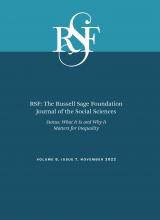Research Article
Open Access
Downplaying Themselves, Upholding Men’s Status: Women’s Deference to Men in Wealthy Families
Annette Lareau
RSF: The Russell Sage Foundation Journal of the Social Sciences November 2022, 8 (7) 112-131; DOI: https://doi.org/10.7758/RSF.2022.8.7.06
Annette Lareau
aProfessor of sociology at the University of Pennsylvania, United States

REFERENCES
- ↵
- Accominotti, Fabian,
- Freda Lynn, and
- Michael Sauder
- ↵
- Benjamin, Lehn M
- ↵
- ↵
- Bessière, Céline
- ↵
- Blair-Loy, Mary
- ↵
- Bourdieu, Pierre
- ↵
- Bourdieu, Pierre
- ↵
- Bricker, Jessie,
- Alice M. Henriques,
- Jake A. Krimmel, and
- John E. Sabelhaus
- ↵
- Chang, Mariko Lin
- ↵
- Collins, Randall
- ↵
- Connell, R. W
- ↵
- Cooper, Marianne
- ↵
- Correll, Shelley J.,
- Cecilia L. Ridgeway,
- Ezra Zuckerman,
- Sharon Jank,
- Sara Jordan Bloch, and
- Sandra Nakagawa
- ↵
- Correll, Shelley J.,
- Katherine R. Weisshaar,
- Alison T. Wynn, and
- JoAnne Delfino Wehner
- ↵
- Cousin, Bruno,
- Shamus Khan, and
- Ashley Mears
- ↵
- Daniels, Arlene
- ↵
- Destin, Mesmin,
- Régine Debrosse,
- Michelle Rheinschmidt-Same, and
- Jennifer A. Richeson
- ↵
- DiMuccio, Sarah H., and
- Eric D. Knowles
- ↵
- Fiske, Susan T., and
- Hazel Rose Markus
- ↵
- Gilding, Michael
- ↵
- Glucksberg, Luna
- ↵
- Gonalons-Pons, Pilar, and
- Markus Gangl
- ↵
- Gonalons-Pons, Pilar,
- Christine R. Schwartz, and
- Kelly Musick
- ↵
- Hansen, Marianne Nordli, and
- Maren Toft
- ↵
- Harrington, Brooke
- ↵
- Hertz, Rosanna, and
- Jonathan B. Imber
- ↵
- Kay, Katty, and
- Claire Shipman
- ↵
- ↵
- Keister, Lisa, and
- Stephanie Moller
- ↵
- Kendall, Diana E
- ↵
- Kendall, Diana E
- ↵
- Krippner, Greta R., and
- Anthony S. Alvarez
- ↵
- Lamont, Michèle
- ↵
- ↵
- Lareau, Annette
- ↵
- Leicht, Kevin T
- Martin, Wednesday
- ↵
- McCall, Leslie
- ↵
- Mears, Ashley
- ↵
- Mesch, Debra,
- Una Osili,
- Jacqueline Ackerman, and
- Elizabeth Dale
- Mills, C. Wright
- ↵
- Moss-Racusin, Corinne A.,
- Julie E. Phelan, and
- Laurie A. Rudman
- ↵
- Nomaguchi, Kei, and
- Melissa A. Milkie
- ↵
- O’Brien, Shay
- ↵
- Ostrander, Susan
- ↵
- Perry-Jenkins, Maureen, and
- Naomi Gerstel
- ↵
- Rao, Aliya Hamid
- ↵
- Ridgeway, Cecilia L
- ↵
- Ridgeway, Cecilia L
- ↵
- Ridgeway, Cecilia L., and
- Shelley J. Correll
- ↵
- Ridgeway, Cecilia L. and
- Hazel Rose Markus
- ↵
- ↵
- Saez, Emmanuel, and
- Gabriel Zucman
- ↵
- Schimpfössl, Elizabeth
- ↵
- Schwartz, Christine R., and
- Pilar Gonalons-Pons
- ↵
- Scott, Joan
- ↵
- Shapiro, Thomas M
- ↵
- Sherman, Rachel
- ↵
- Sherwood, Jessica H
- ↵
- Shiffer-Sebba, Doron
- ↵
- Smith, Ryan A
- ↵
- Smock, Pamela J., and
- Christine R. Schwartz
- ↵
- Stone, Pamela, and
- Meg Lovejoy
- ↵
- Tichenor, Veronica
- ↵
- Toft, Maren, and
- Sam Friedman
- ↵
- Valentino, Lauren
- ↵
- ↵
- ↵
- ↵
- Yavorsky, Jill E.,
- Lisa A. Keister,
- Yue Qian, and
- Sarah Thébaud
- ↵
- Zelizer, Viviana
- ↵
- Zelizer, Viviana
In this issue
Downplaying Themselves, Upholding Men’s Status: Women’s Deference to Men in Wealthy Families
Annette Lareau
RSF: The Russell Sage Foundation Journal of the Social Sciences Nov 2022, 8 (7) 112-131; DOI: 10.7758/RSF.2022.8.7.06
Jump to section
Related Articles
- No related articles found.
Cited By...
- No citing articles found.





